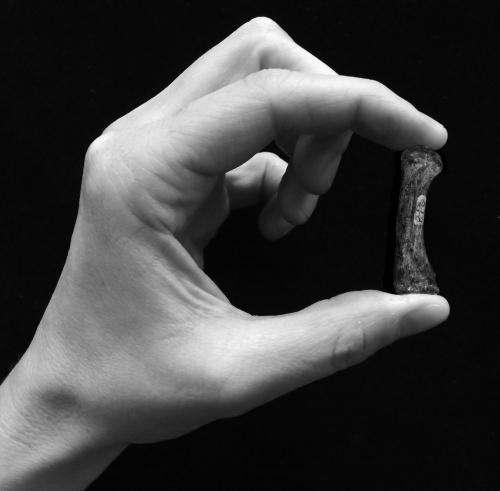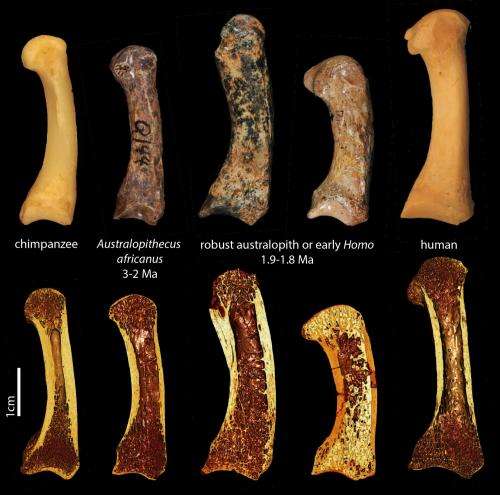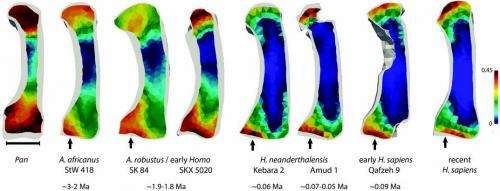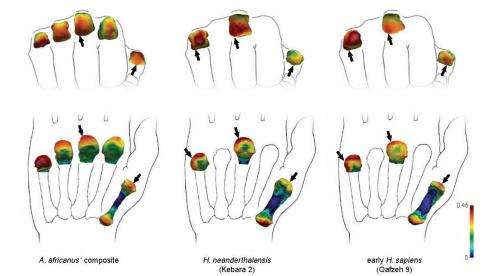Early human ancestors used their hands like modern humans

New research suggests pre-Homo human ancestral species, such as Australopithecus africanus, used human-like hand postures much earlier than was previously thought.
Anthropologists from the University of Kent, working with researchers from University College London, the Max Planck Institute for Evolutionary Anthropology in Leipzig (Germany) and the Vienna University of Technology (Austria), have produced the first research findings to support archaeological evidence for stone tool use among fossil australopiths 3-2 million years ago.
The distinctly human ability for forceful precision (e.g. when turning a key) and power "squeeze" gripping (e.g. when using a hammer) is linked to two key evolutionary transitions in hand use: a reduction in arboreal climbing and the manufacture and use of stone tools. However, it is unclear when these locomotory and manipulative transitions occurred.
Dr Matthew Skinner, Senior Lecturer in Biological Anthropology and Dr Tracy Kivell, Reader in Biological Anthropology, both of Kent's School of Anthropology and Conservation, used new techniques to reveal how fossil species were using their hands by examining the internal spongey structure of bone called trabeculae. Trabecular bone remodels quickly during life and can reflect the actual behaviour of individuals in their lifetime.
The researchers first examined the trabeculae of hand bones of humans and chimpanzees. They found clear differences between humans, who have a unique ability for forceful precision gripping between thumb and fingers, and chimpanzees, who cannot adopt human-like postures. This unique human pattern is present in known non-arboreal and stone tool-making fossil human species, such as Neanderthals.

The research, titled Human-like hand use in Australopithecus africanus, shows that Australopithecus africanus, a 3-2 million-year-old species from South Africa traditionally considered not to have engaged in habitual tool manufacture, has a human-like trabecular bone pattern in the bones of the thumb and palm (the metacarpals) consistent with forceful opposition of the thumb and fingers typically adopted during tool use.
These results support previously published archaeological evidence for stone tool use in australopiths and provide skeletal evidence that our early ancestors used human-like hand postures much earlier and more frequently than previously considered.
-

Sagittal midline cross sections of the first metacarpal in Pan, recent H. sapiens, and fossil hominins. Recent and early H. sapiens demonstrate a palmar concentration of trabecular bone in the proximal base of the Mc1 consistent with forceful opposition of the thumb, which is distinct from the more homogeneous distribution of trabecular bone in Pan. A. africanus, Swartkrans specimen SK 84, and H. neanderthalensis also demonstrate the H. sapiens pattern, suggesting similar loading and use of the thumb. Swartkrans specimen SKX 5020 has a more homogeneous distribution of trabecular bone in the Mc1 base that is more similar to Pan. The distal heads of SKX 5020 and Amud 1, as well as the proximal base and palmar shaft of Qafzeh 9, are not fully preserved. Trabecular bone volume fraction is scaled to 0 to 45%. Credit: M.M. Skinner et al., Science, VOL347, ISSUE 6220 (2015) -

Pattern of trabecular bone distribution in A. africanus, H. neanderthalensis, and early H. sapiens. The A. africanus composite includes StW 418 (left Mc1, mirrored), StW382 (left Mc2, mirrored), StW394 (left Mc3, mirrored), and StW 552 (right Mc4), as well as (*) Swartkrans specimen SK(W) 14147 (left Mc5,mirrored) associated with either A. robustus or early Homo. Arrows point to regions of highest BV/TV (red), indicating a recent H. sapiens–like distopalmar and asymmetrical peak loading of the metacarpal heads in all fossil hominins that is distinctly different from the pattern found in Pan. Trabecular bone volume fraction is scaled to 0 to 45%. Credit: M.M. Skinner et al., Science, VOL347, ISSUE 6220 (2015)
More information: Human-like hand use in Australopithecus africanus, (Matthew M. Skinner, Nicholas B. Stephens, Zewdi J. Tsegai, Alexandra C. Foote, N. Huynh Nguyen,Thomas Gross, Dieter H. Pahr, Jean-Jacques Hublin,Tracy L. Kivell) is published on 23 January in Science: www.sciencemag.org/lookup/doi/ … 1126/science.1261735
Journal information: Science
Provided by University of Kent



















